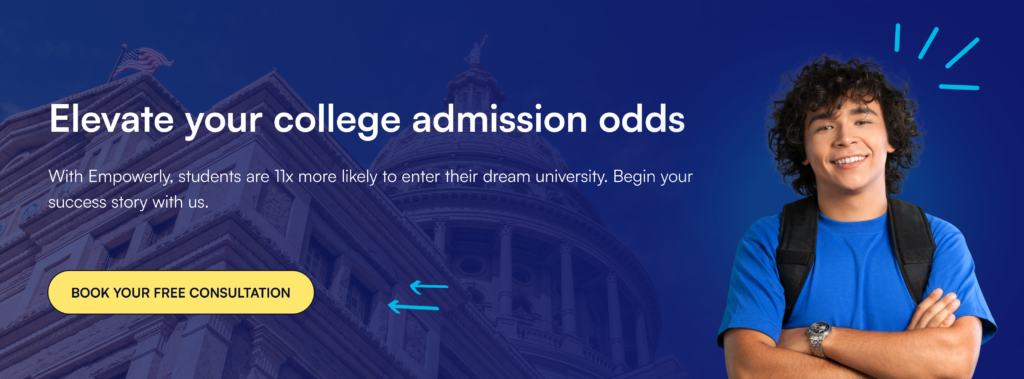You’ve done it. After weeks (or months) of planning, you’ve finally finished your college campus visits! Like Homer’s brave hero Odysseus, you’ve survived an epic journey, faced a variety of trials, and returned home wiser for the experience. In a whirlwind of bustling dorms, lively classrooms, and tree-lined quads, you caught a glimpse of your potential future — and now, you have some decisions to make.
Of course, choosing where you’ll spend the next four years isn’t just another task on your checklist; it’s a highly personal decision that’s influenced by everything from dorm vibes to academic fit. That’s why learning how to compare colleges after a visit is so important.
But there’s a problem: now, despite your best efforts to distinguish them, all the details have started to blend into one long montage of events. You may find yourself staring at your list of schools, trying to remember which one felt the most “right” when you first saw it. The trip was exciting, but all those info sessions have started to blur together… Which dorms looked the most (or least) comfortable to you? Which one had the spacious labs — and which one had the tiny, windowless ones? And that awesome sandwich you had — where was it, again?
Even if you do your best to pay attention and document your trip carefully, it’s hard to know what you should do with the information once you get home.
Fear not. You don’t need an oracle or seer to make sense of all the information you gathered. Grab your notes (whatever you have) and join us at the table. Choosing where you’ll spend the next four years is one of the biggest decisions you’ll ever make. Today, we’ll discuss how to compare and contrast colleges after touring effectively — so you can turn a swirl of impressions into a clear, confident choice.
Why comparing colleges after visiting is hard
Before we jump into strategies, let’s acknowledge why this process of choosing (and understanding) the college list can be so challenging. Take heart; you’re not alone!
So what happened?
- Memory overload: You might tour multiple campuses in a single week (or day, depending on how ambitious your schedule is), making them easily blur together.
- Emotional influence: A charismatic tour guide or sunny day can sway your perception, even if it doesn’t really reflect the overall student experience.
- Your company: If you brought family or friends along, their opinions (or alma mater pride) might unintentionally start to seep into your unconscious bias.
- Information gaps: Sometimes you leave a visit with lingering questions or missing data.
- The stakes: This is your future! It’s natural to feel pressure, and it only makes the decision harder.
In other words: if you feel overwhelmed or emotional, that’s normal. The good news? There’s a proven way to bring structure and clarity to your decision-making process.

How to compare colleges after touring them
Pull up a chair and let’s get to it.
1. Use notes and pictures from your visits.
First things first: go back to your notes, photos, and even the voice memos you may have taken after each tour. Even quick snapshots of dorms, campus quads, or student events can help you remember the personal details of your experience and jog your memory later.
If you didn’t end up taking many photos yourself, no problem. Most schools have campus photos online, and you can use pictures and maps later to connect your memories to the right school. Landmarks and key buildings (like the dining halls) will probably help orient you.
Want to go above and beyond? Add captions to your photos as soon as you take them (“College X, science building lab”). Your future self will thank you when all those buildings start looking alike.
2. Revisit your research.
Campus tours are great for vibe checks, but they can’t answer every question you may have. Sometimes new ideas pop up at random times or occur to you after the fact. Once you’re home, you can take time to research any lingering questions that remain unanswered.
For your research, you can use tools like the College Scorecard, student reviews, or even school-specific hashtags on social media. If you attended info sessions, check whether there are follow-up webinars or virtual departmental events you can join.
3. Stay organized with a comparison system you’ll actually use.
Your impressions are valuable, but only if you can actually use them later. This is where a college comparison spreadsheet or journal comes in handy.
Create or find a table that includes major categories like:
- Academic fit (majors, faculty, research)
- Campus life (housing, food, clubs)
- Location (urban, rural, climate)
- Cost (tuition, scholarships, average cost of living)
- Student support (career services, advising, mental health)
Additionally, file any journal reflections, free-writes, and personal notes you have on loose sheets of paper. The firsthand voice will help you articulate why you’re a good fit for the school, or why you are interested in a particular program, for the “Why Us” essays.
Wondering what those are? This counselor explains:
You may even want to look back on these details when you make your final decision on where to attend.
4. Follow up with people you met.
Did you meet a student, professor, or admissions representative who made an impact on your visit? Helpfully answered a few of your individual questions? Try to get their contact information so you can send a thank-you note or email. It doesn’t need to be long — just genuine and professional.
Why bother? Because it:
- Shows demonstrated interest, which can improve your chances of admission
- Keeps your network warm if you have future questions
- Is good practice for the world of work and beyond
Here’s a bare-bones template you can add to and personalize:
Dear [Name],
Thank you for taking the time to speak with me during my campus visit to [School Name]. I really appreciated learning about [specific topic or program] and look forward to exploring it further. It was great to hear your perspective on the student experience at [School Name].
Sincerely, [Your Name]
Not sure what to talk about, or how to keep the conversation going? Depending on your conversation and context, you can try one of the following:
- Confirm answers to any open questions (majors, internships, support services).
- Ask for recommendations (student clubs, academic advisors, campus events).
- Thank them for their time (keeps connections warm so you can reconnect later).
5. Review the materials you collected.
Those brochures and student newspapers in your backpack? They’re more useful than you think. Real campus publications often highlight student life and events in a way that official websites don’t. These resources could even include a campus literary magazine, a course catalog for the department you’re interested in, or other student club offerings. Re-read them — you may notice something you missed during the tour.
Organize these materials (physical or digital) by school, too, so you can reference them when questions come up.
Bonus: trust your gut, but verify it.
Gut feelings matter here. If one campus felt like “home,” don’t dismiss that — it’s a valid factor. But balance it with evidence: academic fit, cost, and long-term outcomes. The right balance of head and heart will help you make the best choice.

Update your college list
Now that you’ve combed through your notes, it’s time to see how your college list stacks up.
During the whole process, your college list should be a living document — don’t be afraid to make edits and changes as you iterate. We’d recommend using a physical notebook or a software (like Google Docs or Excel) that archives each version of your list, in case you want to recover something you deleted or track how your thinking evolves.
Need a place to start? Download this free college list worksheet for a jump-start on the process:
When to make changes
When it comes to edits now, you may already know certain moves are necessary, but there may be other adjustments as well.
- Did a campus feel completely wrong? Consider removing it. (Remember, if you strike some, you may need to add a few other schools to balance out your list.)
- Were you surprised by how much you liked a safety or backup school? Consider moving it up the list!
- Did you discover a pattern (e.g., you like mid-sized urban campuses)? Seek out other schools like it.
Common mistakes to avoid
Even with the best intentions, students sometimes make these post-tour missteps:
- Choosing based on one tour guide’s personality: a great guide doesn’t guarantee the perfect fit, and vice versa.
- Choosing based on prestige or rankings, without looking at fit; you wouldn’t judge a book by its cover, right?
- Forgetting to write down impressions right away: memory fades surprisingly quickly, especially when your brain is full after multiple tours.
- Letting parents’ or friends’ preferences outweigh or influence your own impressions.
- Ignoring finances: falling in love with a school without at least checking affordability can lead to disappointment later.
- Skipping follow-up research: a quick vibe check isn’t enough for a decision this size. Look at retention rates, program rankings, and campus culture indicators.
Unsure whether you should make the change? First, watch this video on how to make sure you end up with the right decisions for your personal college experience:
Putting it all together
Visiting colleges is exciting and often overwhelming, but it’s only step one. The future truly begins to unfold when you organize your impressions, verify your research, and refine your college list based on what matters most to you.
Parents, you can ask questions about safety, finances, and logistics, but let your student lead the decision-making. Your job is to guide, not decide.
Remember: choosing a college isn’t about finding a perfect school — it’s about finding the right fit for you.
Ready to make your college decision with confidence?
At Empowerly, we help students like you make informed, strategic college choices — whether it’s building a balanced list, preparing strong applications, or turning campus visits into actionable insights.
Deadlines are approaching fast. Book a free consultation today and take the guesswork out of comparing your colleges!
